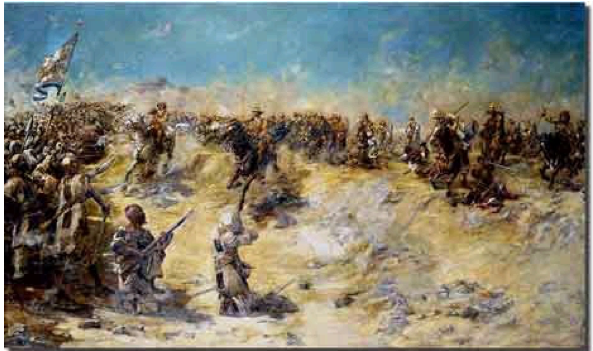In the 19th century, Sudanese territory was claimed by Egypt, which ran a corrupt and oppressive rule over the territory. In 1881 a devout Muslim religious scholar named Muhammad Ahmad declared himself the Mahdi, the legendary prophesied figure that would appear at the end of time and who would herald the arrival of Isa (Jesus) and the Final Judgment. He was able to rally the disaffected tribes of the Sudan against the Egyptians, conquering much of the upper Nile valley. Like ISIS and their caliphate, the Mahdi attempted to reintroduce the pure, harsh Islam of the 7th century.
After several military attempts to defeat the Mahdi, the British (who now controlled Egypt) decided to pull out of the Sudan and sent the charismatic, popular hero General Charles Gordon to arrange the evacuation. Gordon, instead, chose to stay and fight. He and his troops were massacred in the capital Khartoum in 1884, causing an enormous scandal back in Britain. Though the Mahdi soon died, his successor, known as the Khalifa, built a powerful Mahdist state that attempted to spread its variety of Islam by the sword.
In 1898 the British decided to put an end to this threat to European imperialism in Africa, sending an army up the Nile, under General Herbert Kitchener. The Mahdist forces greatly outnumbered Kitchener’s troops but the British had machine guns and artillery. Near the confluence of the Blue and White Niles at Omdurman, the wild charges of the Mahdists (called “dervishes” or “Fuzzy-Wuzzy” by the British) were mowed down by disciplined fire of the more modern army.
Four Victorian Crosses were awarded for that day’s action including one to a Canadian, Captain Raymond de Montmorency of the 21st Lancers (whose charge is depicted here.)

The citation for the medal reads: “At the Battle of Khartum on the 2nd September 1898, Lieutenant de Montmorency, after the charge of the 21st Lancers, returned to assist Second Lieutenant R. G. Grenfell, who was lying surrounded by a large body of Dervishes. Lieutenant de Montmorency drove the Dervishes off, and, finding Lieutenant Grenfell dead, put the body on his horse which then broke away. Captain Kenna and Corporal Swarbrick then came to his assistance, and enabled him to rejoin the Regiment, which had begun to open a heavy fire on the enemy.”
De Montmorency was born in Quebec in 1867, the son of a British general, and he joined the British Army at the age of 20. After Sudan, de Montmorency was assigned to South Africa where he fought in the Boer War, dying at the Battle of Stormberg in 1900.
The classic 1939 movie “The Four Feathers” recreates the Battle of Omdurman with a cast of tens of thousands. It’s quite impressive. Do not, on any account, watch the putrid remake of 2003.